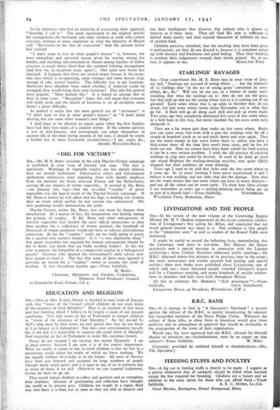STARLINGS' RAVAGES
Snt,—Your contributor Mr. H. E. Bates says in your issue of Janu- ary 3rd, " Starlings are accused of eating wheat . . . but the stomachs of 13 starlings shot `in the act of eating grain' contained 91 cater- pillars, &c., &c." Will you let me say, as a farmer of many years' standing, that what the starlings do is: they do not eat the grain, but they pull up and eat the young wheat just as it is coming out of the ground? Early sown wheat that is up early in October they do not attack, but late sown wheat (sown about November 1st) is what they go for. A flock will go all along each drill and pull up every blade. Two years ago they completely destroyed five acres of late sown wheat in a field here in this way, but never touched the ten acres sown early alongside it.
They are a far worse pest than rooks on late sown wheat. Rooks you can scare away, but even with a gun the starlings only fly off a couple of hundred yards or so and pitch down and start again. They are the worst enemy to late sown wheat there is, unless you have a bird-starer there all the time they won't keep away, and he has his work cut out. Now we cannot have boys from school for bird scaring it can be a very serious problem. I wish the old practice of catching starlings in clap nets could be revived. It used to be done 4o years ago round Brighton for starling-shooting matches, now quite rightly stopped, but their numbers do want thinning.
Years ago I used to be told that larks took the late sown wheat as it came up. In 35 years' farming I have never experienced it and I believe it was starlings and not larks that did the damage. Now they are the worst enemy that late sown wheat can have in many districts— and not all the wheat can be sown early. To show how ideas change I can remember 4o years ago a starling-shooting match being got up






























 Previous page
Previous page